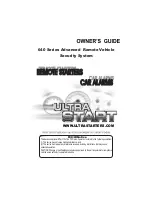
D-303404 GSD-442 PG2 Installation Instructions
5
C-3. Normal COHb levels
Under normal conditions all humans have low levels of COHb of between 0.3% and 0.7% present within the body. These levels are
considered neither beneficial nor harmful.
C-4. Tobacco Smoking
Tobacco smokers are exposed to significant concentration of CO. In cigarette smokers the COHb concentration varies between 5% - 9%
while heavy smokers it may exceed 10%.
Appendix D - Action to Take When Alarm Sounds
In case of harmful levels of CO gas is detected, your detector will go into continuous full alarm, Try to take the following necessary
actions immediately:
1. Push the detector TEST switch to silence the alarm.
!
Warning: Never remove the battery to silence the alarm. Removing the battery removes your protection!
2. Call your emergency service (tel. No. .............), or fire department (tel. No. ............). (Please write the telephone numbers).
3.
Immediately move to fresh air
- outdoors or by opening door/window. Do a head count to check that all persons are accounted for.
Do not reenter the premises nor move away from the open door/window until the emergency services responders have arrived, the
premises have been aired out, and your alarm remains in normal condition.
4. After following steps 1 - 3, if your alarm reactivates within a 24 hour period, repeat steps 1 - 3 and call a qualified technician
(Tel. No. ........) to investigate for sources of CO gas from fuel burning equipment and appliances, and inspect for proper operation of this
equipment. If problems are identified during this inspection, have the equipment serviced immediately. Note any combustion equipment
not inspected by the technician and consult the manufacturer instructions, or contact the manufacturers directly, for more information
about CO safety and this equipment. Make sure that motor vehicles are not, and have not been, operating in an attached garage or
adjacent to the residence.
!
Warning:
Normally an activation of the detector indicates the presence of CO gas. However, the CO gas can be extremely fatal, if it
is not detected. The source of the CO gas may come from several possible situations.
Caution:
This detector will only indicate the presence of CO gas at the sensor. However, you have to be aware that the CO gas may be
present in other areas in the premises.
Action to be taken after the problem has been corrected
Once the problem about the CO gas presence in the premises has been corrected, the detector's alarm should be off. After waiting for 10
minutes, push the Test button, to verify that the detector is properly working again.
Appendix E - Warnings and Limitations
This product is intended for use in ordinary indoor locations of family living units. It is not designed to measure compliance with Occupational Safety and
Health Administration (OSHA) commercial or industrial standards.
Caution
: The detector will only indicate the presence of carbon monoxide gas at the sensor. Carbon monoxide gas may be present in other areas.
Individuals with medical problems may consider using warning devices which provide audible and visual signals for carbon monoxide concentrations under
30 ppm.
The alarm, including the sensor, is not to be located within 1.5m (5 feet) of any cooking appliance.
The detector may not alarm at low carbon monoxide levels. The Occupational Safety and Health Association (OSHA) has established that continuous
exposure levels of 50 ppm should not be exceeded in an 8 hours period. Individuals with medical problem may consider more sensitive detection devices.
The CO gas detector is not suitable as a smoke detector or fire detector. This detector is not suitable to install in an hazardous location as defined in
National Electrical Code.
Carbon monoxide must reach the detector for proper performance of CO gas detection. The detector may not protect people who are at special risk from
carbon monoxide exposure by reason of age, pregnancy or medical condition. In doubt, consult your medical practitioner.
CO detectors may wear out because they contain electronic parts that fail at any time. Test your detector at least every week.
Instruct children never to play with the detector.
Never use detergents or other solvents to clean the detector.
Avoid spraying air fresheners, hair spray, paint or other aerosols near the detector.
Do not paint the detector. Paint will seal the detectors vents and interfere detecting CO gas.
Detailed information on conditions which can result in transient CO situations:
1. Excessive spillage or reverse venting of fuel burning appliances caused by:
a. Outdoor ambient conditions such as wind direction and/or velocity, including high gusts of wind; heavy air in the vent pipes (cold/humid air with
extended periods between cycles).
b. Negative pressure differential resulting from the use of exhaust fans.
c. Simultaneous operation of several fuel burning appliances competing for limited internal air.
d. Vent pipe connection vibrating loose from clothes dryers, furnaces, or water heaters.
e. Obstructions in or unconventional vent pipe designs which amplify the above situations.
2. Extended operation of unvented fuel burning devices (range, oven, fireplace, etc.).
3. Temperature inversions which can trap exhaust gasses near the ground.
4. Car idling in an open or closed attached garage, or near a home.
Appendix F - Troubleshooting
Problem This
means...
You should...
Every 60 seconds, the yellow LED flashes once and 1
beep is heard.
Low battery warning
Replace battery (see SPECIFICATIONS).
When TEST/MUTE button is pressed, the green LED
flashes instead of lighting during 2 seconds.
Detector fault or the battery is
not OK.
Replace battery (see SPECIFICATIONS). If the problem still
exists, replace detector.
Every 60 seconds, there are 3 flashes of the yellow
LED and 1 beep is heard.
Detector end of life/ fault.
Replace battery (see SPECIFICATIONS). If the problem still
exists, replace detector.
CO detector goes back into alarm 6 minutes after the
TEST/MUTE button is pressed.
CO level indicates a potentially
dangerous situation.
If you are feeling symptoms of CO poisoning, evacuate your
home and call your emergency service.
CO detector alarms frequently even though no high
levels of CO are revealed in an investigation.
The CO detector may be
improperly located.
Relocate the detector - see appendix B. If frequent alarms
continue, have home rechecked for potential CO problems. You
may experiencing an intermittent CO problem.
!
Warning!
Changes or modifications to this equipment not expressly approved by Visonic Ltd. could void the user’s authority to operate the
equipment.





















